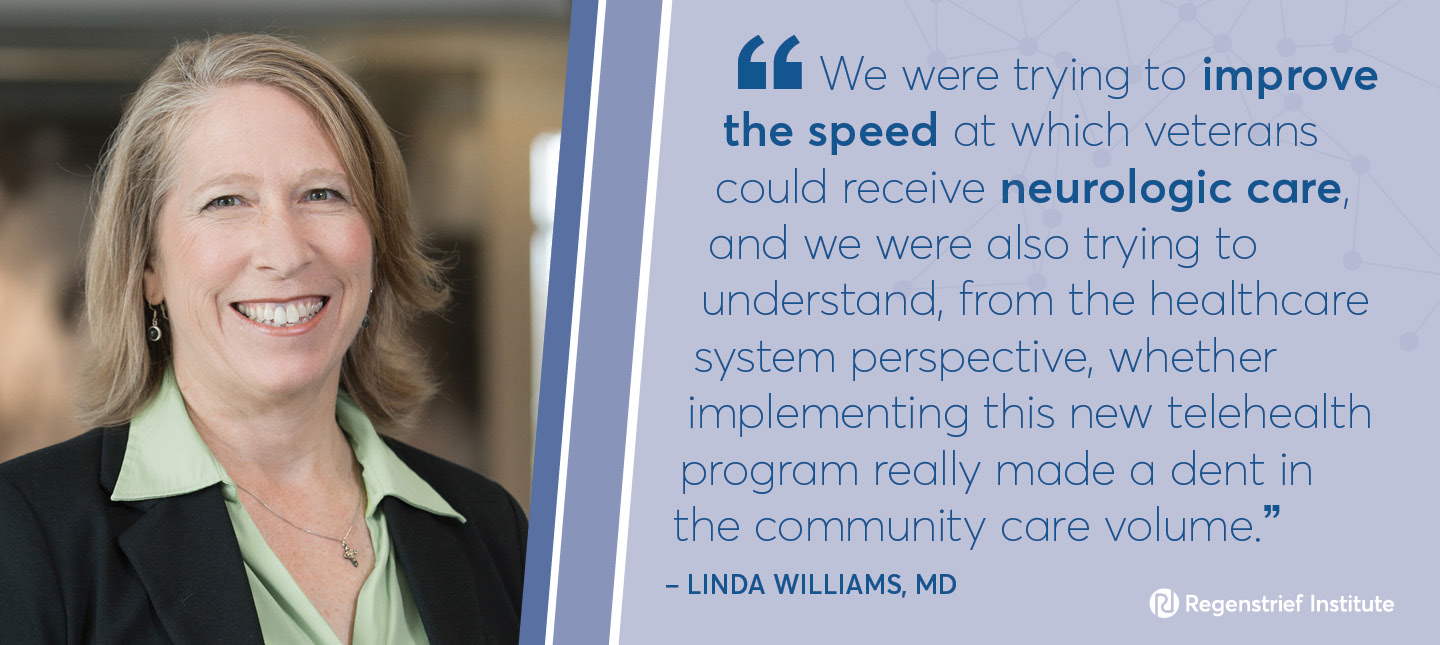One of largest national implementations of telehealth for chronic neurologic conditions
Accessing neurologic care often presents physical, geographical and financial challenges to patients, many of whom face chronic and disabling conditions. With a nationwide scarcity of neurologists in the U.S., especially in rural areas, disparities in access to timely neurological assessment and treatment are not uncommon. Telehealth addresses access to care as well as other inequity issues.
To meet the need for prompter care and to diminish disparity for rural veterans, the U.S. Department of Veterans’ Affairs (VA) National Tele-neurology Program was funded in 2019 by the VA’s Office of Rural Health. The program is a patient-centered, flexible, cost-effective virtual hub model that uses synchronous (video) and asynchronous technologies.
In one of the first and largest studies of outpatient general teleneurology care, a research team, led by Linda S. Williams, M.D., a VA and Regenstrief Institute clinician-researcher, evaluated the innovative program which serves patients with many common conditions including headache, seizures, multiple sclerosis, recent stroke and back pain.
The researchers studied the impact the teleneurology program had on both the timeliness of access to neurological care, as well as the program’s effect on the volume of veteran neurology consultations completed outside the VA system — the only option for most Veterans prior to this new program.
“Telehealth is one way that the VA helps veterans receive care wherever they are. They don’t even have to leave their home,” said Dr. Williams. “And this is very important for some patients with conditions like epilepsy that can make driving difficult and for older patients, who may struggle to drive to a larger city that has a neurologist.
“In the VA teleneurology program, clinicians saw many common neurological problems analogous to those seen in any general neurology clinic. I think our results are likely applicable to non-VA teleneurology programs, although the VA has a very robust infrastructure for teleneurology care and for telehealth care in general, unlike many health systems,” said Dr. Williams.
The researchers compared wait times for appointments at VA sites that had implemented telecare for general neurology patients versus sites that had not yet implemented it and found shorter wait times for telehealth appointments than in-person visits. They also investigated wait times for eligible veterans to receive appointments with a community neurologist due to inability to receive an in-person appointment with a VA clinician. The researchers found that sites which had implemented the teleneurology program did not see a rise in the volume of community care requests in the year after program implementation and that wait time for teleneurology was significantly less than wait times for an appointment with a community neurologist. Sites that did not implement telehealth for chronic neurologic conditions had a significant increase over time in the monthly number of community care neurology consults they placed.
Since passage by Congress of the Mission Act of 2018, veterans living more than 60 miles from a VA facility or those who must wait more than 28 days to receive care from a VA clinician are eligible to receive that care in the community. However, wait time for an appointment with a community neurologist is often quite long, especially in rural areas, where only about 3 percent of U.S. neurologists practice. Four out of five rural counties in the U.S. do not have at least one neurologist.
“When you implement a new program, you need to ask: Does it really make a significant difference in the outcome that you’re trying to reach,” notes Dr. Williams. With this program we were trying to improve the speed at which veterans could receive neurologic care, and we were also trying to understand, from the healthcare system perspective, whether implementing this new telehealth program really made a dent in the community care volume that the VA has been sending out to non-VA physicians, which has been increasing over the past few years.”
The authors conclude, “As the mismatch between the proportion of the population with neurologic conditions and the number of neurologists grows, Teleneurology outpatient care, as demonstrated by NTNP [VA National Tele-neurology Program], is one means of improving patient access to neurologic specialists. This care overcomes some important barriers to access, including rural residence and scarcity of local neurologists, and can be provided with high satisfaction among patients and their referring primary care providers. Although little randomized trial evidence exists to assess the efficacy of telehealth care for chronic conditions, and most of this literature is in patients with diabetes, our study suggests that Teleneurology care not only improves access to care but is feasible and acceptable to patients; future studies should assess the efficacy of Teleneurology care compared to in-person care for ongoing management of patients with neurologic conditions.”
“The VA National Teleneurology Program (NTNP): Implementing Teleneurology to improve equitable access to outpatient neurology care” is published in Journal of General Internal Medicine (JGIM).
The TeleNeurology evaluation was funded by the VA Office of Rural Health.
Authors and affiliations:
Jayne Wilkinson, M.D.1,2; Laura Myers, PhD3; Joanne Daggy, PhD3,4; Holly Martin, MPH3,5; Grace Bastin, B.S.3; Ziyi Yang, M.S.4; Teresa Damush, PhD3,5,6; Aditi Narechania, M.D.7-9; Steve Schriber, M.D.10,11; and Linda S. Williams, M.D.3,5,12
1Corporal Michael J Crescenz VAMC;
2Department of Neurology, University of Pennsylvania;
3Richard L. Roudebush VAMC HSR&D EXTEND QUERI;
4Indiana University School of Medicine, Department of Biostatistics;
5Regenstrief Institute, Inc;
6Indiana University School of Medicine, Department of Medicine;
7Jesse Brown VAMC;
8University of Illinois Chicago;
9Northwestern University,
10Tibor Rubin VAMC;
11University of California, Irvine;
12Department of Neurology, Indiana University School of Medicine
About Linda S. Williams, M.D.
In addition to her role as a research scientist with the William M. Tierney Center for Health Services Research at Regenstrief Institute, Linda S. Williams, M.D., is a core investigator for the U.S. Department of Veterans Affairs Health Services Research and Development Center for Health Information and Communication and a co-principal investigator for the VA HSR&D Expanding Expertise through e-health Network Development (EXTEND QUERI) at Richard L. Roudebush VA Medical Center. She also is a professor of neurology at Indiana University School of Medicine.
About Veteran Health Indiana and CHIC
The Richard L. Roudebush VA Medical Center is the flagship medical center for Veteran Health Indiana, the VA’s healthcare system in central and southern Indiana. The medical center is located in downtown Indianapolis and is collocated with three large community hospitals and the campus of the Indiana University Schools of Medicine and Nursing. The health system has been serving Hoosier Veterans since 1932. As Indiana’s Level 1a, tertiary care Veteran facility and one of only two VHA facilities in the nation to have Joint Commission Stroke Care Certification, the medical center serves as home base for a system of inpatient and outpatient care locations serving more than 62,000 Veterans.
The VA Health Services Research and Development (HSR&D) Center for Health Information and Communication (CHIC) group is a diverse cadre of researchers based at Roudebush VA Medical Center who work together to transform the healthcare system, both within and outside the VA so every patient receives consistent, high-quality care.
About Regenstrief Institute
Founded in 1969 in Indianapolis, the Regenstrief Institute is a local, national and global leader dedicated to a world where better information empowers people to end disease and realize true health. A key research partner to Indiana University, Regenstrief and its research scientists are responsible for a growing number of major healthcare innovations and studies. Examples range from the development of global health information technology standards that enable the use and interoperability of electronic health records to improving patient-physician communications, to creating models of care that inform practice and improve the lives of patients around the globe.
Sam Regenstrief, a nationally successful entrepreneur from Connersville, Indiana, founded the institute with the goal of making healthcare more efficient and accessible for everyone. His vision continues to guide the institute’s research mission.
About IU School of Medicine
IU School of Medicine is the largest medical school in the U.S. and is annually ranked among the top medical schools in the nation by U.S. News & World Report. The school offers high-quality medical education, access to leading medical research and rich campus life in nine Indiana cities, including rural and urban locations consistently recognized for livability.










